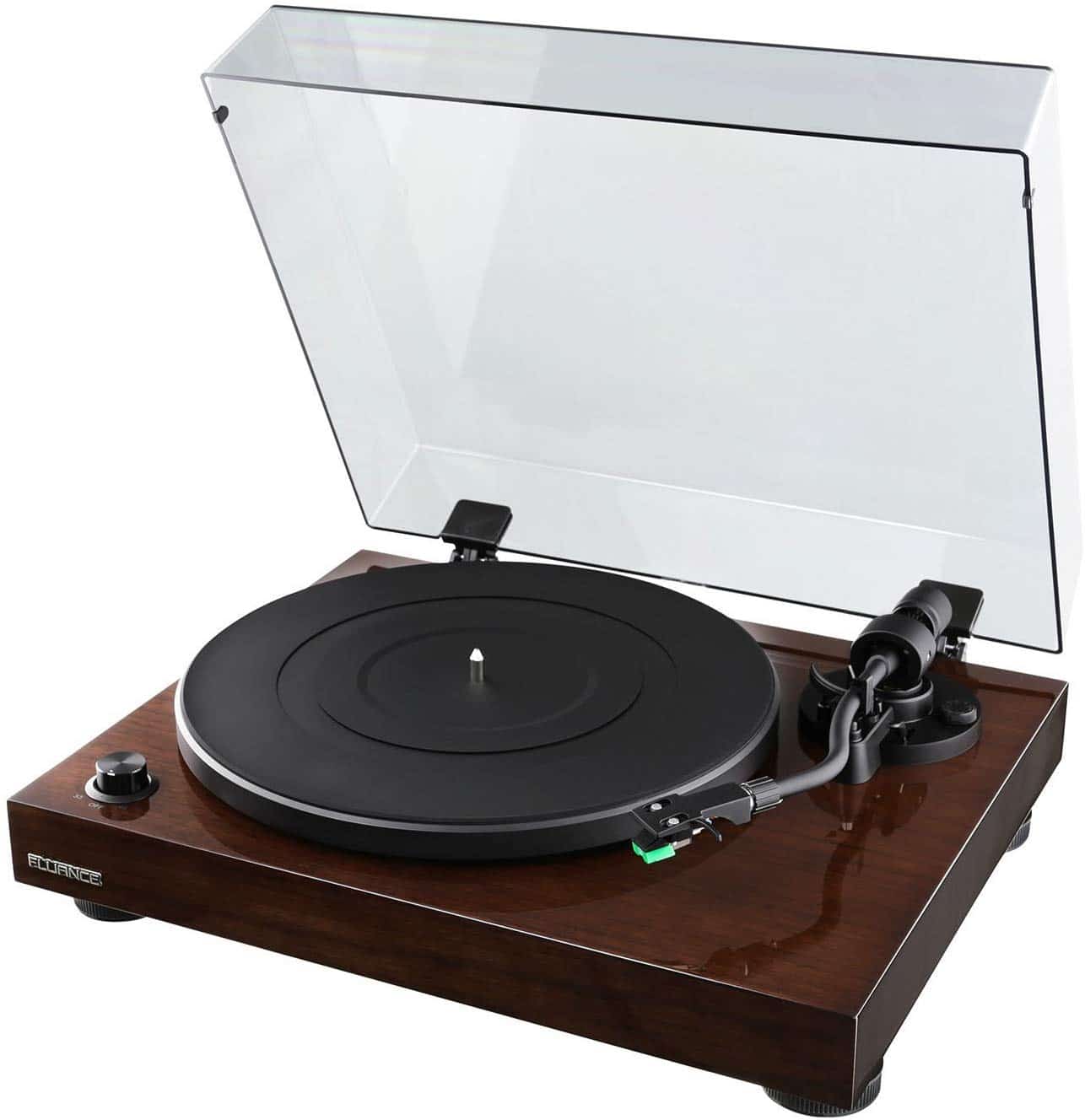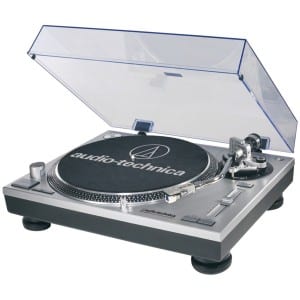Vinyl records were the go-to standard for all music needs at one time. While new technology has allowed us to reduce the size of our audio media, many enthusiasts still choose to buy record players and play all of their old hits in the same fashion that their parents did – or even their grandparents.
Finding the best record player is difficult.
Check Prices At AmazonCheck Prices At Amazon
The truth is that vinyl record players are foreign to most people today. You probably won’t know which features or specs you need to look for when buying a record player. But we’re going to discuss how to choose the best record player for your needs, so you can make a smart purchasing decision.
Note: We’re not going to discuss record players meant for DJs and scratching. The main focus of this article will be audiophile (or focused on sound quality) not record players that are meant for DJs.
Turntable Buying 101
A few basic rules will apply when buying a record player. The biggest concern will, of course, be the price. The great thing about vinyl is that even a basic record player will suffice for most people’s needs. But there are some concerns, especially in the lower price ranges.
Under $100
If you’re on a very tight budget, you’ll be sacrificing sound quality. Lower-end models are also less flexible than their counterparts because you’re not able to easily upgrade them. Many of the mid- to high-priced models will allow for a certain level of customization where you can switch out or upgrade internal parts.
We’ll be discussing the main parts of a record player shortly.
$300 – $500 Price Range
This is the price range where most consumers will fall into. When you spend $300 – $500, you can expect a great quality player that is built with the utmost in sound quality and allows you to upgrade several sound components in the process.
And the sonic difference will be noticeable almost immediately.
If you’re still a beginner in the world of vinyl, this is the perfect price range for you. Yes, there are some high-end models that will produce even better sound and offer better quality, but leave those to the enthusiasts unless you have the extra cash to spend in the process.
$500+
If you’re very eager to buy the best model, you’ll be spending more than $500 on your purchase. These models will have precision audio with exotic designs and several features that are meant to push sound quality to the limit.
Record Player Features
Check Price Drops At Amazon.com
While the thought of some of these features was not even plausible at the time of the original record players, many new models come with advanced features that make playing records just a little more convenient.
USB Ports
The one “new” feature that stands out in my mind is the inclusion of USB ports. What this does is allows you to be able to play your records in vinyl and record them directly to your computer where they can later be converted to mp3 format.
As you can tell, this is great for two reasons:
- DJs
- Converting rare albums to digital media
I do want to make it clear that true enthusiasts will want to be cautioned when considering a model with USB functionality. Why? The consensus among true enthusiasts is that a record player will have sacrificed quality and components when a USB port is available.
The last thing you want to do is purchase a high-end dud that included a USB port at the sacrifice of sound.
And USB isn’t that much of a necessity in most cases. While driving up the cost of the record player, you’ll also find that digital media exists for most of the world’s albums already. If your main purpose is to conserve an old album, check online to see if the record is available – it likely is.
Manual and Automatic Options
You’ll find that there are two main models you’ll have to choose from when choosing a record player: manual and automatic.
What’s the difference?
Manual
Manual players will allow you to actually change the record. When the record reaches its end, you’ll need to pick up the lift arm, turn the record and place it back on the vinyl to play it all over again.
Many people are intimidated by this process. Don’t be intimidated. It’s an easy process, albeit a little time-consuming.
Manual players are not for everyone, especially in today’s world where it’s far more convenient to press a button on a remote to switch the side of an album for you.
Automatic
With an automatic model, you won’t be sacrificing sound quality, and you’ll be able to que up your record player and use a remote control to change the side of the record as you please. This is a great option for anyone that doesn’t want to babysit their record player all day long.
But you’ll pay a slightly higher price for an automatic model, so factor this into your budget.
Record players are a ton of fun for one simple reason – they can be upgraded. When you buy a CD player, you won’t be able to upgrade the unit to be able to boost the sound quality or experience.
Instead, you’re stuck buying a new one.
But the best record player allows you to upgrade a majority of the internal workings so that you’ll be able to enhance your listening experience. I’ll be discussing some of the main components found within a record player shortly, so that you know what you’ll be able to upgrade.
Lower-end models, under $300, will often lack the ability to upgrade the unit.
But when you hit the $300 range and higher, you’ll find that there are even performance packs or bundles that can be sold that allow you to upgrade your record player dramatically.
Upgrade Options
Several components can be upgraded, including the:
- Cartridge: The “housing” the supports the needle or stylus. Upgrading the cartridge will lead to a substantial sound improvement and will protect the stylus in the process.
- Tonearm: The actual arm that holds the stylus. A tonearm can effect that sound quality of the unit, especially when the needle reaches the end of the record. This arm will also define the speed and sound of the record, and needs to be in good condition at all times.
- Belt: The belt that spins the platter. These belts come with either a belt drive or direct drive. A belt drive model may need a new belt to properly rotate the platter, and upgrades are available that offer more longevity and functionality than your turntable.
These are just some of the upgradeable components that will allow you to achieve the highest quality sound and build the best record player for your audio preference.
Points to Consider Before Purchasing Any Record Player
There are several points to consider before making your final purchase. A few of these points include:
- Platter Weight: The weight of the platter allows the unit to maintain speed and minimizes vibrations from the motor. You will find that heavier platters are the best option, with many of these units offering noise isolation as well.
- Signal–to-Noise Ratio: This is a spec that won’t be found on all models, but when it is present, you’ll want to know what this actually means. What this does is tell you how much background noise will be present on a normal record. The higher the decibel number, the better when it comes to signal-to-noise ratios. Anything above 70DB will be perfect for the majority of listeners.
- Playback Speed: Proper rotational speed is important because it allows your records to play at the proper speed and level. The right speed will depend on the record you’re attempting to play. Some records are very fast and may need a speed of 78RPM, which is difficult to come by. In the majority of cases, 33 1/3 – 45 RPM models will be available and will work adequately.
Always remember that the best sound output will also depend on your environment. You’ll want to allow for adequate distance from the listener and the record player, and the ideal perspective to allow sound to travel to the listener with minimal distortion in the process.
With the best record player, you’ll be left wondering how you ever listened to a CD or cassette player and actually enjoyed the music.
There’s a reason that the top DJs in the world still use turntables – they offer superior sound to even the newest technology available.



